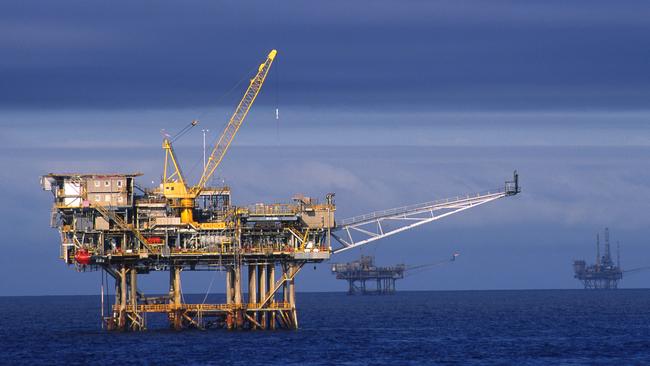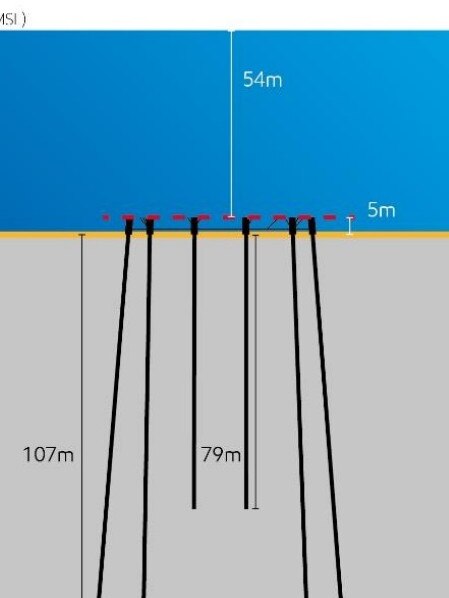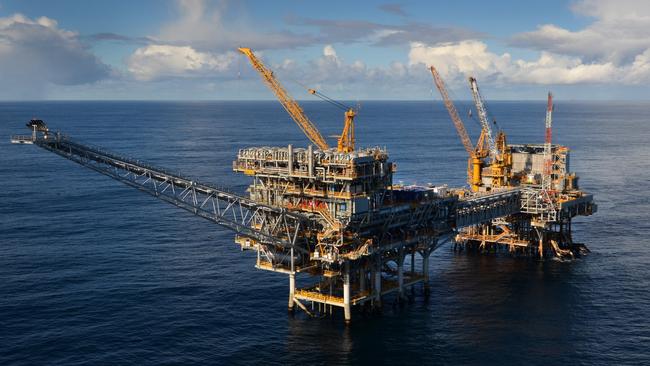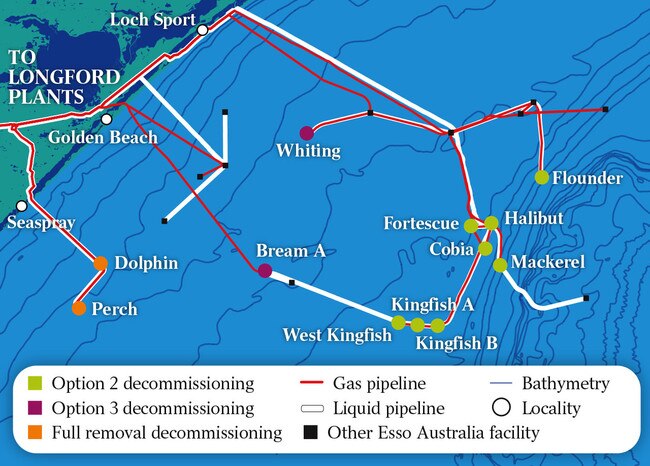ExxonMobil’s bid to leave parts of the Bass Strait ‘ghost’ oil and gas platforms in place
ExxonMobil claims some of the giant Bass Strait oil and gas structures were designed never to be removed.

Business
Don't miss out on the headlines from Business. Followed categories will be added to My News.
Australia’s offshore oil and gas regulator is set for a major test as global oil giant ExxonMobil prepares for the complicated task of dismantling nearly a dozen ageing oil and gas platforms in the Bass Strait.
ExxonMobil, one of the owners of the Gippsland Basin joint venture Esso Australia, has argued that because some of the platforms are as much as 60 years old, they have become part of the marine environment.
It also claims some of the platform structures were designed never to be removed and were made strong to withstand wild Bass Strait storms, which means it would be highly risky to dismantle and extract the steel supports below the surface of the ocean.
The arguments have come about despite rules in place requiring the “complete removal” of all offshore gas and oil structures at the end of their life.

For Esso Australia which oversees the project, the partial dismantling of the platforms would represent a significantly lower cost than removing all steel supports, including those beneath the ocean floor. Indeed some structures have been embedded more than 150 metres into the ground below the seabed.
The arguments have been made in a 660-page environmental plan to the National Offshore Petroleum Safety and Environmental Management Authority which has been made available for public consultation. Plans for decommissioning are not usually released for public comment, but in this case Esso Australia has asked for it to be made available.
“Esso has not been able to establish any Australian or international precedents of (platform) foundation piles being removed to their full extent beneath the seabed,” it says in the submission.

“Given the lack of precedents and the technical issues outlined, a reliable and safe execution method has not been established for this activity. If such a method could theoretically be engineered, the configuration and number of the piles to be removed … would likely require an execution duration of many years and vast seabed and ecosystem disturbance to allow access to all piles for cutting and removal”.
NOPSEMA will be forced to rule on the proposal with the agency still dealing with the fallout from the collapse of the company behind the Northern Endeavour oil ship in the Timor Sea, leaving taxpayers footing hundreds of million of dollars in clean-up costs.

A recent report commissioned by National Energy Resources Australia found there is $52bn of decommissioning work on Australia’s offshore oil and gas infrastructure that still needs to be completed. Half of this is earmarked to begin over the next decade.
There is no suggestion of a funding shortfall for Esso Australia given the joint ownership by ExxonMobil and ASX-listed Woodside Petroleum. Some fields remain in production.
While a joint venture, ExxonMobil is very much in the driver’s seat in the Gippsland Basin, with Woodside inheriting the maturing gas fields last year as part of its $40bn merger with BHP’s petroleum arm.
Through its merger with BHP Petroleum, Woodside has set aside as much as $2.7bn for decommissioning costs until the end of the decade, although that also includes operations in the North West Shelf as well as Bass Strait.
Deep water cut
For eight of the platforms including the massive Kingfish structure, Esso is proposing to cut the footings the platforms sit on so there is 55 metres of clearance between the ocean and the steel structure sitting on the ocean floor. For another two platforms Esso is planning to cut them as close as possible to the seabed.
It is still considering how to dispose of the main platforms, with the options being transporting them onshore where they will be cut down or placing some of the sections on the seabed next to the steel footings.
The plan doesn’t detail exactly how the works will be carried out given that they will be subject to a separate review and approval process by the regulator.
The dismantling of the platforms is also a stark symbol of how the Bass Strait gas reserves that have powered Australia’s east coast for the past 50 years are fast running out.
Under the venture some 10 platforms, three subsea facilities, 16 pipelines and approximately half of all wells drilled are no longer producing oil and gas.
Esso is planning for the first wave of dismantling to start from 2027. Work already underway includes the plugging of wells that have stopped production and basic work is underway for the preparation of the removal of the platforms.
Esso says further decommissioning will be required in the future, with another 13 platforms sitting in Bass Strait still producing gas, using a network of 600km of underwater pipes. This is why it is keen to get an initial ruling on the partial dismantling.

For its part Esso warns damage from the removal of the platforms is likely to cause significant harm to the seabed and potentially leakage into the water. It argues the facilities were installed in a different era where they weren’t planned to be removed.
“In order to ensure the integrity of wells producing to the facilities, the (platforms) were designed to withstand 1-in-100-year storm events and the depth and design of the deep foundation piles reflects this,” it says in its submission.
“The consequence of this design is that these deep foundation piles were engineered to provide a strong, secure, and enduring bond with the soil.
“Future removal was not a consideration of the design standards of the day and no feasible method of complete removal at depth has been identified.”
While the waters where the wells are located fall outside Victoria’s three nautical mile coastal water claim, the state government has a strong interest in seeing the fields fully restored. Pipeline infrastructure and the Longford processing facility are captured by Victorian environmental regulations while the state regulator also oversees fisheries.
A spokesman for Esso Australia said the energy company was committed to decommissioning the Bass Strait offshore facilities “safely and effectively”.
“We are managing the decline in Bass Strait oil and gas production by streamlining our operations, transitioning from Australia’s oldest oil and gas business to a modern Australian gas company, which will continue to provide local employment opportunities for years to come,” he said.
The spokesman said detailed evaluation and assessment has highlighted the options, which “balance the retention of the extensive ecosystems that have developed on and around the platforms since their installation with the needs of communities, government and non-government stakeholders”.
NOPSEMA has issued a tight window for feedback with submissions closing at the end of this month.
Following this Esso has said it will prepare a public consultation report and outline any changes made to the environmental plan then submit this to the regulator.
“NOPSEMA will consider the public comments and any subsequent changes to the environmental plan when undertaking the formal assessment,” a spokesman for the regulator said.
johnstone@theaustralian.com.au



